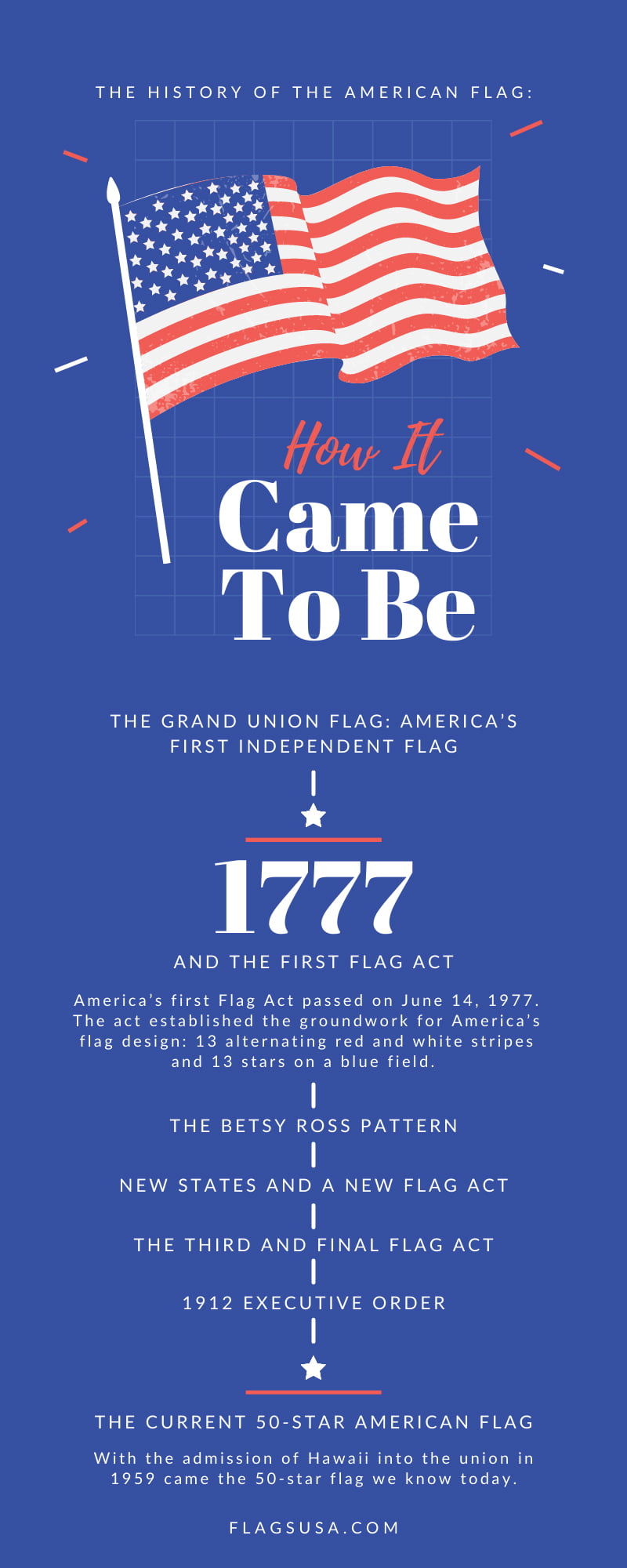No products in the cart.

The American flag has been flying—in one form or another—for nearly 250 years. Over the course of nearly two centuries, three official Flag Acts, and the admission of 37 states to the union, dozens of different designs have flown over the country throughout various parts of our history. During this time, the flag has come to mean a lot of different things for a lot of different people. How did it all begin, though? Explore the history of the American flag and how it came to be with this overview.
America has seen a lot of variations of the flag over the years, but the original is the most unique variation. Before the colonies declared independence from Great Britain, the Grand Union flag represented the unity of the 13 colonies beneath British rule. Like our current flag, this design consisted of 13 alternating red and white stripes to represent the colonies. Instead of white stars on a blue field, however, the corner of the flag bore a Union Jack.
The Grand Union flag reflected the colonies’ original fight to gain representation in British parliament. It also served as a compromise between the colonists who desired independence and those who wished for a compromise with the crown.
Congress declared independence from Britain in 1776, but the call for an original national flag didn’t come until nearly a year later. America’s first Flag Act passed on June 14, 1777. The act established the groundwork for America’s flag design: 13 alternating red and white stripes and 13 stars on a blue field. The flag represented the 13 colonies, and the stars represented a new constellation—the newly independent country’s hope for its future.
There are contradicting records about who designed the original American flag, but one of the most popular potential designers is Betsy Ross. Ross was an upholsterer and flag maker for the Pennsylvania Navy. Many believe that she designed and made the original American flag featuring the 13 stars in a circular pattern. However, some speculate that the design itself comes from Frances Hopkinson, a signer of the Declaration of Independence.
While we don’t have solid records to say for certain who designed the flag, the fact remains that this first flag of the Revolutionary Period is often called the Betsy Ross flag. Similarly, the circular star pattern is also known as the Betsy Ross Pattern, securing Ross’s name as a founding mother and legendary creator of the flag.
Congress’s first Flag Act only gave a brief description of what the flag should look like. Details such as the orientation of the stripes, the placement of the blue field, and the layout and number of points of the stars were still unclear. As a result, flag makers had some liberty with their designs. Variations such as different proportions and layouts appeared across the colonies. The designs of the stars were another big variable, with many flags portraying six-pointed stars.
The 13-star flag persisted throughout the Revolutionary War and in the years after. However, when Vermont and Kentucky became states in 1791 and 1792, respectively, Congress had to rethink the flag’s design.
Congress passed its second Flag Act in 1794. This act changed both the number of stars and the number of stripes to 15. The resulting flag became known as the Star-Spangled Banner, and it was this 15-starred and 15-striped flag that inspired Francis Scott Key to write “Defence of Fort M’Henry,” a poem which later became the lyrics to America’s national anthem.
New states joined the union in the following years, but there was no official act that addressed them. Even though some citizens designed and made flags to reflect the current number of states, those variations were never official American flags.
The country continued to grow before and especially after the War of 1812. With more states entering the union, Congress decided to pass a third and (so far) final Flag Act. This act declared that the flag should have only 13 stripes to represent the original 13 colonies. It also declared that the current flag was to have 20 stars to represent the current number of states, and that a new star should be added for every new state that enters the union. Thus, the modern design of the American flag was born.
While the third Flag Act established the design rules we use today, it still didn’t address certain design specifications. Proportions and details varied across the country. Namely, the layout of the stars and the number of points on each star could change from flag maker to flag maker.
A uniform design didn’t exist until President William Howard Taft signed an executive order clarifying certain details. The 1912 directive was a crucial moment in the history of the American flag and how it came to be. The order declared that the stars—representing 48 states at the time—should be arranged in six horizontal rows of eight stars. Each of the stars should have five points, with one point facing upward.
This executive order created the 48-star flag, which is the second-longest-flying flag in America’s history. The 48-star flag flew for 47 years and represented the country through both World Wars and eight presidencies.
When Alaska joined the union in January 1959, the new 49-state flag also followed President Taft’s executive order, with the small alteration of having seven rows of seven stars. This flag flew for a single year before Hawaii became a state.
With the admission of Hawaii into the union in 1959 came the 50-star flag we know today. The modern American flag first flew on July 4, 1960. Like the two versions before it, this flag follows President Taft’s executive order. It bears nine rows of stars—five with six stars alternating with four rows of five stars—staggered to form eleven columns. The 50-star flag has flown for over 60 years, making it the longest-used flag in the nation’s history.
From small-town families to CEOs of international companies, American citizens have been flying the American flag in one form or another for generations. Flags USA sells American-made American flags so that you too can partake in this tradition. With quality materials and passionate design, we help businesses and organizations find a lasting flag that they can proudly display on their property. Visit us today to learn more about our products and the fascinating history, etiquette, and meaning of the American flag.


Custom flags are fantastic for spreading your logo and communicating messages. Whether you’re marking your spot at events or handing out flags to potential customers, there are plenty of ways to advertise your business through flags. As with any marketing investment, you must consider your options and needs before settling on the right type of flag for your campaign. To help you make an informed decision, here’s our guide to the different types of advertising flags.
Outdoor banners let you promote your business in other parts of the community. Whether you’re advertising along the city’s busiest streets or expanding your display at a market or fair, banners are an attractive way to do it.
Avenue banners display on light poles or other streetside fixtures. These banners are usually smaller, but they hang in prime viewing spots for hundreds or even thousands of commuters each day. Avenue banners are double-sided, durable, and classy. They’re a great way to promote throughout the community and establish your business as a trusted local brand.
Having teardrop banners is a fun and unique way to show off your business at events. The sleek teardrop design catches the eye without taking up too much space. This banner is perfect for standing out at tradeshows or community events. You can also use teardrop banners outdoors. The teardrop shape and heavy-duty poles make them reliably wind resistant, so they’re perfect for outdoor markets, fairs, and similar opportunities.
Branded handouts make for great promotional materials. Of the different types of advertising flags, mini flags are some of the most wonderfully creative options. Miniature flags are fun and easy products to give out at events. Kids might not care what the flag says, but they’ll have fun waving it around wherever they go. Meanwhile, adults will see different mini flags floating around and notice your business. Plus, miniature flags roll up until they take only a tiny amount of space, making them a convenient branding tool to give out during events.
When you want a durable flag that’s easy to set up, turn to flutter flags. These flags feature rounded corners that allow them to continuously move with the wind without fraying. Flutter flags are fast and easy to set up or take down, giving you the mobility and versatility that you need to display your brand wherever you go.
At Flags USA, we make it easy to find the perfect advertising flag for your business. Contact us today to learn more about our branded flags.

Displaying a flag in front of your business or organization is a great way to demonstrate who you are and what you stand for. Whether you’re showing patriotism with the American flag or showing off your logo with a custom flag, you want to purchase a flag that will look great and last a long time.
As with any big purchase, it’s important to shop carefully and ensure you’re buying the right flag for your needs. You may know some basic points, such as double-checking the flag’s design. However, you should also keep in mind the following factors to consider when buying a flag.
The biggest question to ask yourself before buying a flag is where you plan on flying it. If you want one to fly on a tall in-ground pole, you need to look for a durable outdoor flag that can withstand temperature changes, high winds, and other environmental factors. If you’re looking for an indoor flag, you probably want something smaller and possibly more ornate to serve as a proud decoration.
Once you know where you want to fly your flag, you can start looking at more details. Another major factor to consider when buying a flag is its material. Quality materials and stitching are keys to purchasing a flag that will fly for a long time without fraying.
Material is particularly important for outdoor flags. Manufacturers often use nylon or polyester in outdoor versions. Nylon is the most common choice and can hold up against moderate weather. For higher winds or extreme conditions, you want the superior durability of polyester. For example, polyester is suitable for flags on in-ground flagpoles, which fly higher up in the air where the wind is more powerful.
Indoor flags don’t face harsh weather conditions, but you still want high-quality materials that look good on display. Once again, nylon is a popular choice. You can also purchase cotton flags for a more traditional look.
Buying American-made products is a great way to support domestic businesses and invest in your country’s economy. When you buy flags—especially American flags—you’ll find the best available quality, performance, and durability.
At Flags USA, our online flag store makes finding the perfect flag and flag accessories more convenient than ever before. So visit Flags USA today.